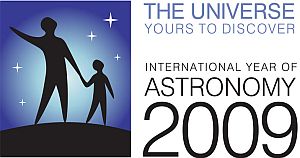
The
International Year of Astronomy (IYA2009)
was a global celebration of astronomy and its contributions to society and culture, highlighted by the 400th anniversary of the first use of an astronomical telescope by Galileo Galilei.
The aim of the Year was to stimulate worldwide interest, especially among young people, in astronomy and science under the central theme "The Universe, Yours to Discover".
The IYA2009 activities took place at the global and regional levels, and especially at the national and local levels. National Nodes in each country prepared activities for 2009.
These Nodes established collaborations between professional and amateur astronomers, science centres, educators, and science communicators. Below you will find links to the national nodes of the countries that partipate in the ING.
This official final report shows the many activities oprganised at all levels, their evaluation and conclusions.
And below it's the list of projects and initiatives that ING organised, collaborated with or endorsed:
GLOBAL PROJECTS
100 Hours of Astronomy *
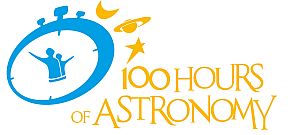
This is a 100-hour, round-the-clock, round-the-globe event that includes live webcasts from research observatories, public observing events and other activities around the world.
ING participated in the "Around the World in 80 Telescopes" webcast,
live 24-hour research observatory webcast from
the William Herschel Telescope on the night 3/4 April 2009, reporting on the Isaac Newton Group of Telescopes and some of our sientific highlights.
More information on the 100 Hours of Astronomy event can be found here:
100 Hours of Astronomy web site,
IAU press release.
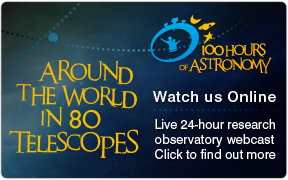 The video of our webcast from the William Herschel Telescope can be downloaded from:
The video of our webcast from the William Herschel Telescope can be downloaded from:
100 hours of astronomy
Ustream
ESO
The video comprises 4 video conferences: GTC telescope,
the WHT, the SST and the TNG, all telescopes of the Roque de los Muchachos Observatory. On the previous day, the 2nd of April 2009, we also participated in a radio live programme reporting on Spanish astronomy. Listen here
the Radio Nacional de España's programme "España Directo".
We also collaborated with the initiative "100 Hours Junior" somehow, as during the days of the event we showed around a group of students (12-16 years) and teachers from the Marlborough School, UK, who could join the observers at the William Herschel and Isaac Newton Telescopes, observed the Moon
using the finder on the Jacobus Kapteyn Telescope and participated in the webcast from the William Herschel Telescope (watch video provided at the link above).
From Earth to the Universe

The
“From Earth to the Universe” project is an exhibit arranged by the IYA2009 that will bring a selection of superb astronomical images to a wider audience in non-traditional venues such as public parks and gardens, art museums,
shopping malls and metro stations around the world. ING has contributed several images from its telescopes.
Portal to the Universe
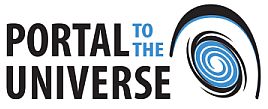
The portal to the Universe seeks to provide a global, one-stop portal for online astronomy content, serving as an index, aggregator and a social networking site for astronomy content providers, laypeople, press, educators, decision-makers and scientists. The Isaac Newton Group
of Telescopes has registered for this project, in particular, as content provider in the fields of blogs, images and videos suppliers, and news RSS feeds.
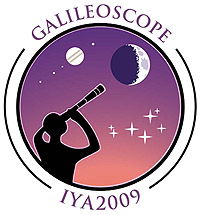
The Galileoscope *
ING has supported the purchase of a number of Galileoscopes for distribution at the secondary schools on La Palma and at the
exhibit "¡Mira qué Luna!" (see below), being organised in Santa Cruz de La Palma.
The Galileo Teacher Training Program *

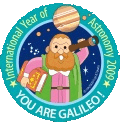
ING has suported the use of the Galileoscope at the La Palma secondary schools, including the use of some of the material from the project
"You are Galileo!"
(Galileo Teacher Training Program). Our local project for secondary school students and teachers
"Our pupils and the Roque de los Muchachos Observatory" (see below) will also benefit from the material provided by this global project.
The Galilean Nights *
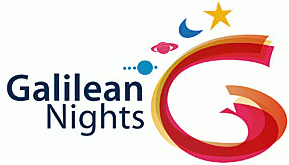
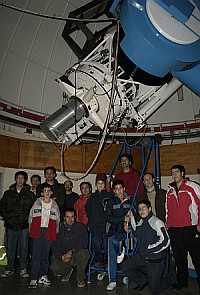
ING joined the Galilean Nights 22-24 October by inviting a group of amateur observers based on La Palma to observe the Moon and Jupiter with the
JKT finder telescope on the night of the 23rd of October, 2009 (see picture above). We went through the pages of Galileo's Sidereus Nuncius and tried to recognise the drawn features of the Moon and Jupiter in that book.
REGIONAL PROJECTS
Astronomy for the public 
ING collaborated with this Spanish activity which aims at making astronomy present in everyday life (stamps, lottery, tickets, etc.), and one of our contributions was the use of the image of the "Herschel
Deep Field" on the
ONCE lottery tickets on the 14th of March 2009. The web site of the project can be found here:
www.astroparatodos.es.
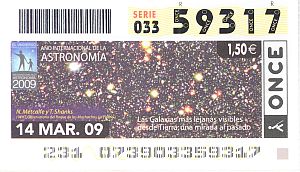 ONCE lottery ticket showing the Herschel Deep Field
ONCE lottery ticket showing the Herschel Deep Field
Explorers of the Universe 
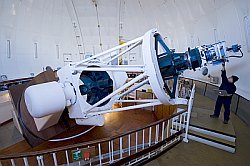
The project is funded from a major 'Science in Society' grant in the UK. The photographer Max Alexander is photographing approximately 40 UK astronomers and would like to take
one of the pictures at the ING.
This exciting venture will be realised as an exhibit (
Royal Albert Hall, London: 24th Sept – 2nd Nov, 2009), book and website, and will have various media tie-ins, all timed to happen during IYA2009.
The aims of the project are to raise public awareness and engagement with astronomy and space science, and to attract young people into science.
STFC Press Release.
Astronomy in the streets * 
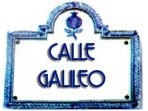
This Spanish initiative involves local authorities naming streets,
squares, etc. with astronomical terms. ING has volunteered to provide its own suggestions for naming places on La Palma after
astronomical objects which are the subject of advanced research carried out with the ING telescopes. On the 14th of August a street was named "Vía Láctea" (Milky Way) in Santo Domingo village,
head of the Garafía municipality in which the telescopes are located.
Astronomy 'made in Spain' 
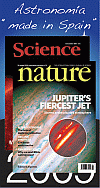
This project aims at collecting the main discoveries made by the Spanish astronomers, published in the journals
Nature and
Science.
ING has provided a complete list of
Nature and
Science papers published since first light in 1984, that have made use of data collected with the ING telescopes,
and in which a Spanish astronomer was involved. These highlights were published in the book, "Astronomía Made in Spain" (ISBN 978-84-612-9883-9).
We are also collaborating with the Spanish Sociedad Española de Astronomía and El País newspaper in
providing material for the permanent supplement Especial de Astronomía. This gallery of images
is a good example.
Moonwatch weeks and Jupiter SkyWatch 
To celebrate the International Year of Astronomy (IYA2009), UK's
Society for Popular Astronomy (SPA) promotes observing the Moon with a telescope among thousands of secondary schoolchildrens, to help inspire young people (aged between 11 and 14)
with the wonders of the night sky. At ING, we joined this initiative by offering the possibility of observing the Moon by naked eye to a group of schoolchildren from Marlborough School, Oxford, UK, using the finder of the
Jacobus Kapteyn Telescope, during the
SPA's Spring Moonwatch week.
We are also planning to join the Jupiter SkyWatch and Autumn Moonwatch week.
"Sorpresas del Cosmos" exhibit 
We collaborated with some images for the exhibit
"Sorpresas del Cosmos" organised by the
Instituto de Astrofísica de Canarias (IAC) and the
Instituto Cervantes .
This is an astronomical exhibit which will travel around the world at the different centers of the Instituto Cervantes with the intention of showing the astronomy made in Spain as part of its cultural heritage.
More information:
Centro Virtual Cervantes and
Nota de prensa.
Una Universidad, Un Universo * 
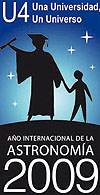
The project
"Una Universidad, Un Universo" aims at giving at least one astronomy lecture in every Spanish university,
for both humanities and science students and teachers. We have scheduled two talks in November to be given at the
Centro Asociado de la UNED - La Palma (UNED is the Spanish distance-learning university) in Santa Cruz de La Palma and at its extension center in Los Llanos de Aridane. Both talks are given by Javier Méndez and their
titles are as follows: "Los grandes temas de la astrofísica actual" (for humanities teachers and students) and "Desarrollos actuales en instrumentación y técnicas astronómicas" (for science teachers and students).
"Evolución", a planetarium program
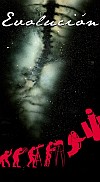 "Evolución"
"Evolución" is a planetarium Spanish production by
Planetario de Pamplona, la Casa de las Ciencias de la Coruña y el Museo de las Ciencias de Castilla-La Mancha about astronomy, biology and geology coinciding with the 250th anniversary of
the publication of Charles Darwin's "Origin of Species" book. We showed the production team around the ING telescopes in March 2009, and they could take some wide-field photographs. The programme was first
shown in April 2009.
El Universo para que lo Descubras
El Universo para que lo Descubras * is Spanish project partially based on the global project "From Earth to the Universe"
which aims to have an itinerant exhibit of astronomical images accompanied by a description and text from known writers. The exhibit can also be shown on a high-resolution video which will show during the
local exhibit "¡Mira qué Luna!" (see below).
LOCAL/OWN ACTIVITIES
Reporting on our science
We would to report on the ING science giving public talks, writing on our research, the research done with our telescopes or anything about astronomy that can be attractive to the general public.
If you are the editor of a magazine,
a web site or similar and you want our contributions, please let us know. Below you can some of the public outreach articles recently published by our astronomers.
- Miguel Santander, "Carretera hacia las estrellas: guía para perplejos", Caos y Ciencia, 13/02/2009.
- Javier Méndez, "Las Estrellas a Nuestros Pies", a blog written in Spanish and published in the local digital newspaper elapuron.com.
- Miguel Santander, "Materia y energía oscura: guía para perplejos", Caos y Ciencia, 05/06/2009.
- Miguel Santander, "Agujeros negros (I): guía para perplejos", Caos y Ciencia, 01/09/2009.
- Miguel Santander, "Planetas Extrasolares: guía para perplejos", Caos y Ciencia, 22/02/2010.
The ING astronomers are also keen on giving talks in Spanish or in English to local audiences, in particular to local students and teachers, La Palma visitors, etc. Please contact us if you can organise
one of these public talks. Our talks last 45 minutes plus questions, and we show a powerpoint presentation on our activities: the work at the observatory, the research we do, the developments, etc. We can also
set an amateur 20-cm telescope up for night observing.
"¡Mira qué Luna!" exhibit *
¡Mira qué Luna! is an exhibit taking place from the 28th of november to the 5th of december, 2009 in Santa Cruz de La Palma. It´s about a
historical overview of Moon research and observations from 1609 to present time, including historical texts from the Brera Observatory in Italy and recent research results and images
from the Roque de los Muchachos Observatory. Several user institutions of the Roque de los Muchachos Observatory will make a joint
effort to prepare this exhibit and it will consist of panels, videos, talks, music, Moon observation, presents (Galileoscope) and a small library dedicated to the Moon with books
from the John Whelan Library (ING).
Talks on cruises
Some touristical cruises from UK and elsewhere stop at La Palma port. We´ve contacted these cruise operators as we are interested in
giving talks on board.
Chris Benn, ING Head of Astronomy, has joined a RAS initiative to give an astronomy talk on board of one the Cunard cruises (see for instance this Queen Mary 2´s programme).
Project "Our Pupils and the Roque de los Muchachos Observatory" *
In collaboration with other institution at the Roque de los Muchachos Observatory, we are participating in an initiative to
bring astronomy regularly, and starting in 2009, to every secondary school on La Palma, by giving a talk, providing a visit to the observatory and having some on-hands experiences. This project is called
"Nuestros Alumnos y el Roque de los Muchachos".
Naked-eye observations with JKT's finder telescope *
The finder of the Jacobus Kapteyn Telescope is a refractor with an aperture of 20cm and a focal length of 3250mm. Because it´s ideal for naked-eye observations, we thought we could use it
for public observations and to commemorate the first astronomical use of the telescope by Galileo in 1609.
We have refurbished JKT's finder and planned some special observing sessions throughout
the year coinciding with particular events, as follows: the students of the Marlborough School (UK) could use it to observe the Moon during the SPA's Spring Moonwatch week;
the winners of STFC's Christmas Card competition used it to observe the Moon and Jupiter in August; the winners of the "Stellar Raffle" organised to help those affected by
the La Palma fire in July, 2009, could observe the Moon, Jupiter and some deep-sky objects; a group of invited amateur observers from La Palma observed the Moon, Jupiter and several Messier objects on the Galilean night 23rd October, 2009.
*: Activity organised by the LPIYA Group. The LPIYA Group
gathers communicators and
representatives from every ORM user-institution and the Instituto de Astrofísica de Canarias (IAC) with
the objective of organising and coordinating IYA2009 and Beyond activities on La Palma.



